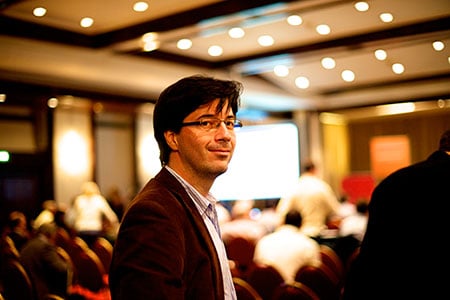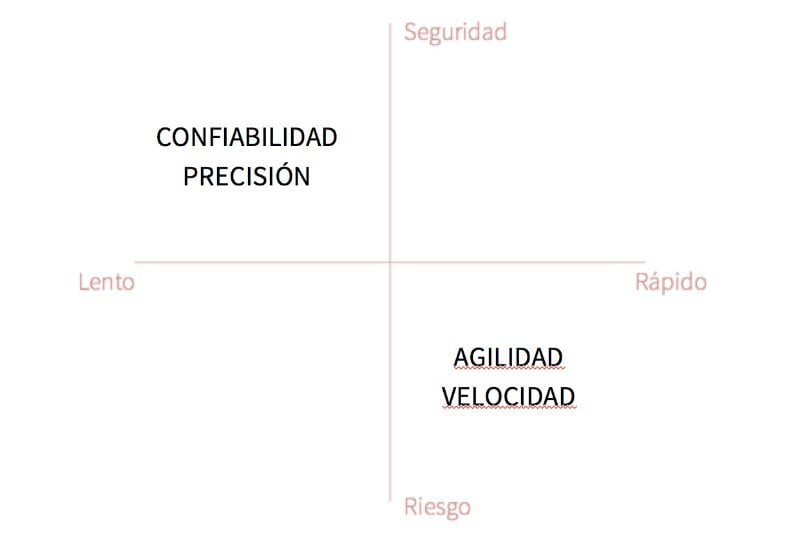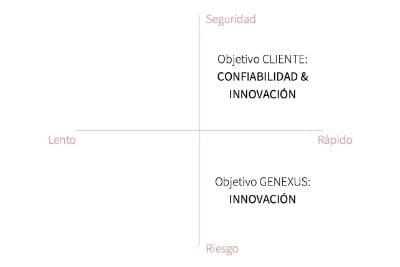What we've learned about GeneXus by working with Gartner (by Gabriel Simonet)
BI-MODAL IT + DIGITAL TRANSFORMATION + DIGITAL ASSETS = COOL VENDOR

This is an article that describes how working with Gartner has provided us with deeper insight into what GeneXus has been doing for almost three decades, which is to digitally transform enterprises in the fastest and safest way while preserving their digital assets.
A little over six months ago, after many long discussions, we started working with Gartner (a company that conducts consulting and research on information technology). Basically, while working with them we gained access to their reports and their analysts' views, and this allowed us to explore the most important and current concepts in the world of technology. Also, we learned how GeneXus' value proposition can be better positioned and leveraged in various contexts and markets.
We found that over time, GeneXus had been mentioned in several reports, but only as a niche option in Latin America. It was time to do something about it! In addition, the most recent reports were at least ten years old, so another reason that led us to approach Gartner was to undertake GeneXus evangelism efforts with their assistance. However, discovering the Bi-Modal IT concept among the trends they perceived in the market gave us the final push to start the project.
BI MODAL IT
Gartner has identified a common reality in all the IT departments of companies and has proposed a solution called BI MODAL IT. The problem -which is real, it hasn't been fabricated by Gartner-, is that IT departments must provide services and systems that are safe and reliable for the sake of business, but on the other hand, businesses also need agility and speed to innovate and remain relevant in the market.

These two forces -RELIABILITY and AGILITY- are opposed and can be displayed in a simple grid. Let's look at Reliability and Innovation in a 2 x 2 matrix.
On one hand, we have business systems which are stable, safe and slow to change and adapt, and bring reliability to businesses. On the other hand, we have systems that are developed very fast to respond immediately to new market realities. These systems pose more risks and are potentially unstable.
To solve both problems succesfully, Gartner proposes this solution: the existence of TWO TEAMS with different skills and objectives. One team is responsible for keeping the business running, and the other team is responsible for bringing innovation to customers, whether internal or external.
Each team is in a different quadrant; one of them is focused on reliability, and the other is focused on innovation. They require people profiles and processes that are completely antagonistic.
Thirty years ago, GeneXus had already realized that companies had the same problem or need, but it had offered a different solution.
Our idea is that the GeneXus development team should work on the innovation quadrant, doing research, innovating, and assuming the costs and risks of learning and implementing new technologies. In this way, GeneXus customers and users can work in a special third quadrant and have RELIABILITY and INNOVATION at the same time.

For more than 8,500 companies, GeneXus is the R&D department that generates solutions aimed at streamlining access to new technologies, in order to innovate in a reliable, safe and agile way... all at the same time!
However, BI-Modal IT isn't the only interesting concept that we discovered about GeneXus by reading Gartner.
DIGITAL TRANSFORMATION
Gartner often speaks about digital transformation and how companies must evolve their business and operation models to adapt to the actual needs of the market and avoid becoming victims of a technological disruption caused by a competitor.
GeneXus has been helping companies to digitally transform and adopt new technologies since its beginnings in the late '80s. What's more, many GeneXus competitors haven't been able to survive the various waves of technological advances that GeneXus customers have successfully navigated.
Regarding digital transformation, Gartner affirms that it requires devising and designing the content or solution, as well as implementing the idea through technology. The first part can be easily solved by business professionals, but the second part requires technical experts, and they both need to communicate, understand each other and work as a team to achieve success.
GeneXus is precisely one way of creating and developing applications focused on descriptions of the business, greatly bridging the gap between the business analyst and the functional analyst, making it possible for them to talk about the same entities or objects, and look at the same issues. In sum, it facilitates dialog and the implementation of software innovations in companies.
DIGITAL ASSETS
Lastly, another interesting concept that we came across is that of digital assets. These are the assets that companies need to focus on more and protect as they go digital if they want to stay in business in the future and not perish.
The most important digital assets that companies have are data, metadata and algorithms. In the future, they will become even more important. Another great advantage provided by GeneXus when compared to other development platforms or tools is that, building on the business knowledge accumulated in the software development phase, GeneXus infers the logical and physical data and metadata model, and stores the algorithms inside its projects, not in the code of the application. Then, it uses that knowledge to automatically create the applications and work with the data and databases that are in production.
In particular, there is much talk about algorithms being the future of business and how they are critical to their survival. However, the same emphasis is not being placed on the fact that business algorithms are “written” using code, and that this code is always in a programming language that will change or become obsolete in a very short time. This represents a big effort on the part of companies; when faced with each new technology wave they have to learn a new technology and rewrite code, which is nothing short of reinventing the wheel with a different material. It is an endless cycle unless software has been programmed using GeneXus.
More Gartner: GeneXus selected as a Cool Vendor
The three concepts that we were introduced to by Gartner can be used to clearly explain what GeneXus does and why it makes sense to use it to create business applications: GeneXus helps the digital transformation of companies while preserving their digital assets, through a strategy that addresses the same problems as those described by BI-Modal IT.
This is GeneXus' differentiating feature because customers that started to work with GeneXus at the end of the '80s to create green screen software are now able to create applications for the latest platforms, just by incorporating new elements and using the same language and the same knowledge contained in their projects.
This is what GeneXus has been doing for almost three decades (and can prove it): to digitally transform companies in the fastest and safest way while preserving their digital assets.
After working closely with GeneXus, Gartner analysts got to know it better, and the first noticeable result of this interaction and knowledge is that GeneXus has been included in Gartner’s Cool Vendors in Spanish Latin America, 2016. The report, written by analysts Luis Anavitarte, Federico De Silva, Fernando Elizalde and Mónica Zlotogorski, was published on April 29, 2016.
We're extremely proud of GeneXus being considered a Cool Vendor and hope that this is only the first time GeneXus is mentioned by Gartner in this new stage.